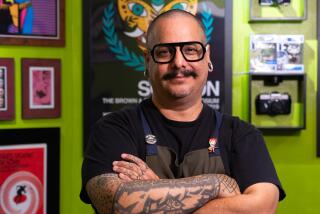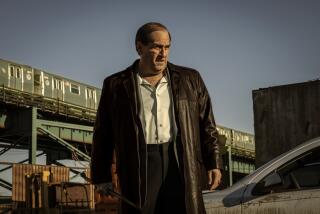Heroes of a Different Color : Pow! Whoosh! Comic-book super-heroes of every ethnicity and gender are out to leap tall stereotypes in a single bound.
- Share via
He can leap tall buildings in a single bound. He’s also a conservative black extraterrestrial lawyer--whose real-life fans include Supreme Court Justice Clarence Thomas. Call him Icon.
He’s faster than a speeding bullet. He’s also an indestructible Korean avenger who confronts the near-omniscient Nun of the Above. Call him Xombie.
Icon and Xombie may not be household super-heroes yet. But in the multicultural ‘90s, even comic-book Establishment stalwart Batman is romancing an African-American doctor named Shondra.
Krak! Pow!!!!
The white-male comics club is going kaboom! as comics, the handbooks of American pop culture, are truly becoming publications of many colors. Just as the country’s cultural firmament embraces heroes of every ethnicity and sex, so too, the fantasy worlds of Dakota and Gotham are finally echoing the complex reality they embellish.
“Like all American media, (comics have) reflected the culture, which means there were things in the 1930s and the 1940s and the ‘50s I’m sure we’d be less proud of today,” says Paul Levitz, vice president and publisher of DC Comics. “But in modern times, there have been either heroes or supporting characters introduced in our line that represent different ethnic groups and the world.”
In the past few years, the landscape has broadened to include not just more prominent characters of color, but comics companies owned and operated by minorities as well as multicultural titles put out by other publishers. About 30 titles claim the multicultural mantle, and even mainstream comic books are flirting with ethnic issues and characters.
Toronto artist Ho Che Anderson created a biography of Martin Luther King Jr. in comics form, and filmmaker Spike Lee linked up with Oregon-based Dark Horse to co-publish a limited run of comic books called “Floaters.”
Black independent publisher Turtel Onli will autograph his comics at a Nov. 27 show in the Crenshaw District’s Bak-tu-jua Gallery. Onli, the Chicago creator of the long-established “Nog: Protector of the Pyramids,” pointedly calls the show of 15 titles from various artists “The Black Age of Comics.”
“It’s hard for people to (accept) that artists of African descent do something distinctive and it should be distinguished as that,” he says. “But it’s really no different from what happens in music. Music with a black influence is categorically respected for what it is. You don’t listen to Jimi Hendrix and expect to hear Liberace.”
Such efforts are rich veins in the booming billion-dollar comics business. Indeed, adding politically correct punch to super-heroes is turning out to be lucrative. In an unusual publishing partnership, Time Warner’s giant DC Comics linked up this year with a multicultural company, Milestone, which has sold more than 3 million copies of its four monthly titles--”Icon,” “Blood Syndicate,” “Hardware” and “Static.”
Soaring off Milestone’s covers are heroes as diverse as the starchy lawyer Icon and the streetwise super-powered gang Blood Syndicate. Unlike traditional super-heroes, many of the multicultural heroes grapple with such terrestrial bugaboos as teen pregnancy, AIDS and race relations.
“We looked at the industry in 1991 and found there was a paucity of characters of color and we said, ‘How can we present our new heroes for today’s society?’ ” says Milestone president Derek Dingle. “We wanted to show that the black experience is diverse. You get a sense of validation to see yourself in fiction.”
Milestone has captured favorable critical attention as well as consumer dollars.
“We’ve been very impressed with what we’ve seen,” says Maggie Thompson, co-editor of the weekly industry bible, Comics Buyers’ Guide, based in Iola, Wis. “The bottom line of anything in our field is how entertaining is the product. That’s how everything is judged by the consumer.”
Not quite everything. Some folk concerned with ushering in the next generation welcome multicultural comics for more than their entertainment bang.
“Comics in the past have been almost entirely white figures, so little children are painted an all-white world,” says Harvard University psychiatry professor Alvin Poussaint. “It’s not the world they’re living in or the kind of neighborhood they’re living in. (Multicultural comics) lay a foundation for them being nonprejudiced. And by showing diverse characters, it tones down white supremacy in the culture.”
But the fledgling movement, as some insiders refer to it, has stumbled in some of its baby steps. Milestone has come under fire from some of the black independent publishers for signing on with the largely white, corporate Establishment.
“I don’t think there’s a message in Milestone comics at all,” says Alonzo Washington, publisher of Omega 7 Comics, based in Kansas City, Kan. “It’s really a chocolate-dip Superman. Any image of an African-American beyond a person going to jail or playing basketball is positive. But with the independents, we’re trying to do more than produce a black super-hero. We’re trying to correct stereotypes passed down on African-Americans for years and years. It becomes more than a money thing.”
Milestone shrugs off such criticism. “Our work speaks for itself,” says editor Dwayne McDuffie. “Milestone is about breaking monolithic views of people of any race. You can decide whether we’re Afrocentric or multicultural or what is, in my opinion, really good entertainment.”
A group of three black independents, ANIA (Swahili for “protect and defend”), has tried to stress a united front among publishers since its recent parting with a flamboyant Atlanta member, Nabile Hage. Hage, who publicly condemned Milestone, also courted press attention for his company, Dark Zulu Lies Comics, last year by climbing out onto a Georgia statehouse ledge dressed as a Zulu warrior and tossing comic books to bemused passers-by.
Although ANIA is sensitive to any appearance of “black-on-black” disputes, it is battling accusations of racism because its membership is exclusively African-American.
“I want ANIA to have an outlook in the media as a positive company that’s Afrocentric,” says member Roosevelt Pitt Jr., the creator of “Purge” comic, based in Greensboro, N.C. “We’re not multicultural the way Milestone is. A lot of people have branded us as racist, saying, ‘You don’t have Asians or Latins.’ The reason we’re Afrocentric and dealing only with Afrocentric concerns is we’re African-Americans. That’s what we know.”
Comics have hoed quite a long row since less-enlightened decades when they mostly traded on racial stereotypes. Typical was a pudgy, pigtailed Chinese henchman predictably dubbed Chop Chop who appeared in the 1940s comic the Blackhawks. And World War II saw particularly vicious characterizations of Japanese.
Not all portrayals of African-Americans were stereotypes, although they were rarely the stars. A few titles made stabs at creating a black universe--All Negro Comics was aimed at black readers when it appeared in June, 1947, but it quickly vanished.
Some characters fared better, although in secondary roles. Walt Kelly, who created the popular Pogo, uplifted the shuffling Buckwheat character from “Spanky and the Little Rascals” when he did a comic-book version of the series. He changed the name to Bucky and portrayed him as a sharp track star.
While comics began to reflect a deepening concern with civil rights in the 1960s, it wasn’t until the ‘70s that black characters became a presence. Coinciding with “blaxploitation” films, three long-lasting characters made their debut--Black Lightning, Black Panther and Luke Cage. Black Lightning was a DC Comics schoolteacher who fought crime in his spare time; Black Panther, an African prince who comes to America, was introduced in Marvel’s Fantastic Four and soon graduated to his own book (a film version with Wesley Snipes as the Panther is in development at Columbia), and hero-for-hire Luke Cage, an off-and-on character since 1972, ignited reader protest when Marvel announced the comic book would be discontinued this month.
“I am sorry but not surprised to learn that the Cage series will be discontinued,” wrote Minnesota reader Matthew Bell. “Sorry, because there are very few comics titles with strong black leads for us black readers to purchase; not surprised, because since white comics buyers are the majority, I’m sure there just wasn’t enough support from them for this type of urban-bred hero.”
Marvel spokeswoman Pamela Rutt says Cage was suspended because monthly sales dipped below 100,000 but she said the company had no information on the demographics of Cage’s readership.
“It just wasn’t pulling the kind of numbers we like to see titles pull,” she said. “What we do is suspend it and relaunch it with a different bent. This could go on with any number of titles at any time. There’s nothing extraordinary about this.”
But Gary Groth, editor of the critical trade monthly Comics Journal, agrees that reader demographics have helped perpetuate the universe of white super-heroes.
“It’s the chicken-and-egg question,” he says. “The market is mostly white teen-age boys. The reason is that the content has been aimed at white teen-age boys. That’s why women and black adults don’t read comics. Most literate, intelligent people don’t read comics. We’re trying to change that, but it’s really difficult to do.”
Indeed, women compose less than 10% of the comics audience, although it wasn’t always so. In fact, when Wonder Woman first appeared in the ‘40s, readership was about 50-50. She sprang full-grown from the mind of the man who invented the lie detector, William Moulton Marsden.
“He was a psychiatrist and if you read the early Wonder Woman stuff, it’s staggering in its psychological implications and ramifications,” Thompson says. “The whole bondage concept is very strong.”
Wonder Woman wielded the Girdle of Loving Submission, which she used to tame the villainesses she captured. Rather than a gun, she carried a lasso, whose captives were bound to obey her will. Her bracelets looked like the remnants of shackles.
But creations have largely been like their creators--white males. (There are, however, now proportionately more women creators--25%--than women readers, Thompson says.)
“I don’t think many people we encountered were evil,” says Dennis O’Neil, who edits Batman. “They just hadn’t any reason to question their assumptions.”
And those who did have been discouraged by the forces of political correctness, writes creator Peter David in Comics Buyers’ Guide. “There is a great temptation to keep comic book heroes--indeed, all fictional heroes--as vanilla-pudding as possible. Why? Because you know you won’t offend anyone.”
David adds that when he wrote a Hulk issue that grappled with AIDS, he had one gay character present another as his “companion.” He was roundly blasted for dodging the word “lover . “
“I’ve been accused of being gutless in portraying homosexuals, of presenting insulting stereotypes of Hispanics and Japanese, and--my personal favorite (because he’s Jewish)--of being anti-Semitic.
“Boy, and that’s for someone who’s been a liberal Democrat since the age of 18. Could you imagine if I were a right-wing conservative?”
The new generation of multicultural creators are banking on having a better shot at avoiding unintended comics pratfalls. Most are in their 20s and 30s, artists who grew up on comics and remember such unlikely cartoony ethnic trademarks as Luke Cage’s fondness for the exclamation “Sweet Christmas!”
In the end, minority creators may bring super-heroes--and ordinary heroes--down to Earth by providing an earnest dose of reality. Emblematic of that push is “Love & Rockets,” which is, at 11 years, the oldest continuously published Latino comic book, its creators say.
It’s an adult title produced by Studio City brothers Gilbert Hernandez and Jaime Hernandez and published by Seattle-based Fantagraphics Books. It tells of Palomar, a mythical Latin American village of ordinary people.
“Superficially, you can look at ‘Love & Rockets’ say, ‘This is surreal,’ ” says Gilbert Hernandez. “But at the same time, it’s rooted in reality. That’s the trick.”
More to Read
The biggest entertainment stories
Get our big stories about Hollywood, film, television, music, arts, culture and more right in your inbox as soon as they publish.
You may occasionally receive promotional content from the Los Angeles Times.










